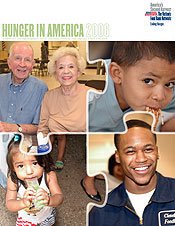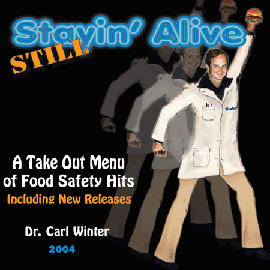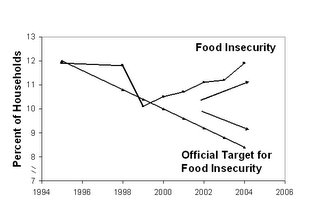
Thanks to the CSPI website for the link.
CHICAGO—February 23, 2006—More than 25 million Americans—including nearly 9 million children and 3 million seniors—receive emergency food assistance each year from America's Second Harvest—The Nation’s Food Bank Network of charitable agencies, representing an 8 percent increase since 2001, according to a report released today. Hunger in America 2006, based on 52,000 face-to-face interviews with people seeking emergency food assistance and more than 30,000 agency surveys, is the largest, most-comprehensive study ever conducted on domestic hunger. The study was commissioned by the America's Second Harvest Network and sponsored by Altria.The research for the report released this week was conducted by a leading consultancy on food assistance issues, Mathematica Policy Research, Inc., on behalf of America's Second Harvest, with financial support from Altria -- the parent company of Kraft foods and Philip Morris cigarettes.
“It is tragic and alarming that more and more people are relying on emergency food assistance in the United States, where we produce enough food to feed every hungry person in the world,” said Robert Forney, President and CEO of the America's Second Harvest Network.



In modern-day America, it’s obesity, not starvation, that is harming kids and killing people who should be in their prime.In the most interesting sections of the column, however, Holmes gives her main thesis a second thought.
But food stamps are still buying soda pop, potato chips and deep-fried frozen dinners — and according to cashiers, buying them in droves (the U.S. government can’t be bothered to track purchases).
It’s the all-American irony: Our land of riches is killing us, especially our poorest and most vulnerable.
That’s why it’s time to put some strings on this entitlement, which, in Indiana, has shot up 85 percent in the last five years alone.
It’s a taboo topic. Politicians and decent folk duck it like the plague. There’s an ugly tone about the question, that conjures up the sentiment: I can have my cake, but you can’t eat yours, too.I fear I may be one of the "polititians and decent folk" Holmes has in mind. What bad company those decent folk keep!
Yet what’s wrong with limiting junk food to 10 percent of benefits? Why not reserve 15 percent for fresh fruits and vegetables? Why not say we want our billions to go to building healthy bodies and strong brains, not diabetes, cancer and heart disease?
My friend Aletha, who often uses food stamps to get by, argues it’s cruel and un-American to single out the poor for the nutritional police.
“Nobody ever listens to that darn food pyramid,” she argues. She’s making efforts — weaning herself from the cheap, empty calories so appealing in the freezer case when her benefits come in. But that’s her choice to make, not mine, she argues.
“If you let the government intrude into food choices, where are they going to draw the line?”
I understand her sentiments.
Among women, food stamp participants are not getting relatively heavier over time. Rather, BMI has grown more among eligible nonparticipants -- and even among women with higher incomes -- than for food stamp recipients. This is especially true for non-Hispanic White women. In 1976-80 and 1988-94, White women who participated in food stamps had greater BMI and were more likely to be overweight and obese than eligible nonparticipants and those with higher incomes. By 1999-2002, these differences had largely disappeared; the only exception was that White women in the moderate/high income group were still less likely to be obese than food stamp recipients. The closing of the BMI gap is due to changes in weight status by nonparticipatingng women -- the average BMI of food stamp recipients remained steady. For non-Hispanic Black women and Mexican-American women, the trends are not as striking, but the general picture is the same.Among Non-Hispanic White women, body mass index (BMI) has held steady for Food Stamp Program participants while continuing to increase for nonparticipants.

Like Mildred Avenue in Dorchester, dozens of schools across the Bay State -- including some in Natick, Framingham, Billerica, and Marlborough -- offer vending machines stocked exclusively with healthy choices.
But a lunchtime visit to Mildred Avenue yesterday showed that school officials and lawmakers cannot control what students eat by changing what is sold in vending machines. Children bring candy and other snacks from home or buy them on their way to school. And they don't think the proposed law would change their eating habits.
I think any sensible advocate for candy sales bans would say the goals are to reduce the ubiquitous presence of candy sales, and to end the hypocrisy of having adults in school preach good nutrition and at the same time make money selling candy to the kids, all during an epidemic of childhood obesity. The candy sales bans look to me like great policy, by those more realistic standards.
Jan's next paragraph makes things worse by quoting, without rebuttal, a student's justification for preferring to keep candy sales in school.'Sometimes, we have headaches and we need sugar in our heads," said Yarmisha Cofield, a Mildred Avenue seventh-grader who ate the $1.29 tube of sour candy and only picked at her school lunch of fried chicken.In terms of policy, the article makes a fairly toothless "compromise" bill under consideration today in the Massachusetts Senate look good by comparison to the stronger bill under consideration in the House. Most nutritionists would consider the sports drinks that are permitted under the Senate bill to be little better than the caloric sodas the bill prohibits.
The panel therefore concludes that hunger is a concept distinct from food insecurity, which is an indicator of and possible consequence of food insecurity, that can be useful in characterizing severity of food insecurity. Hunger itself is an important concept that should be measured at the individual level distinct from, but in the context of, food insecurity.... The panel urges USDA to consider alternate labels to convey the severity of food insecurity without the problems inherent in the current labels.Currently, the federal food security survey asks 18 questions about symptoms of food-related hardship and, on the basis of the number of affirmative responses, classifies households as "food secure," "food insecure without hunger," and "food insecure with hunger." The food security statistics are heavily used in government to evaluate the success of anti-hunger programs (one might better say the limited success, given that the rate of household food insecurity has been rising for several years). The report points out that the term "hunger" is particularly "evocative" and politically potent. If, as seems possible, the report's recommendations cause a halt for several years in federal efforts to measure how many Americans are "hungry," it will be a significant disappointment to anti-hunger advocates. That, in turn, would remove one of the main constituencies that has supported the fairly expensive survey collection effort.
The panel concludes that an overall national estimate of food insecurity is not appropriate as a measure for meeting the requirements of the GPRA. Even an appropriate measure of food insecurity or hunger using appropriate samples would not be a useful performance indicator of food assistance programs, because their performance is only one of many factors that result in food insecurity or hunger. Consequently, changes in food insecurity and hunger could be due to many factors other than the performance of the food safety net.This recommendation also entails a loss. The GPRA act specifically asks federal agencies to evaluate the success of their programs using genuine outcome measures (like reducing hunger) rather than process measures (like delivering a certain number of free meals). Furthermore, I am not sure this recommendation is based on clear reasoning. It is quite correct that factors other than government programs also influence food insecurity and hunger, and yet rates of food insecurity and hunger may still provide useful information about the success or failure of major national anti-hunger and anti-poverty programs over time.
USDA Should Improve Methods for Gauging Food InsecurityThe link on the front page of the NAS website currently runs to the earlier phase I report released last year (and discussed here and here). At the request of the panel that produced that report, I presented a paper about how the federal food security measure is actually used (.pdf).
Feb. 7 -- The U.S. Department of Agriculture has conducted extensive research on hunger and food insecurity in America, but the department needs to improve how this work is carried out to better inform policymakers and the public, says a new report from the National Research Council.
[North Dakota] Agriculture Commissioner Roger Johnson is urging the federal government to rethink its strategy for regaining the market for U.S. beef in Japan.
"I have asked U.S. Secretary of Agriculture Mike Johanns to let U.S. packers voluntarily test all beef they export to Japan for bovine spongiform encephalopathy (BSE)," Johnson said Friday. "Our best hope for regaining our beef markets in Japan is to give the customers what they want."
Johnson said U.S. policy has failed because USDA has treated the matter as a public health issue, not a marketing issue.
"USDA's approach of continually browbeating the Japanese government into taking a product which is viewed with suspicion by the Japanese consumers has now resulted in even further erosion of Japanese consumer confidence in U.S. beef," Johnson told Johanns. "Let's give our customers what they want. That has always been the key to success in any business."


The publication comes from a company called NutraIngredients, and its reporter added some quotes from supplement industry f0lks at the bottom of the article. Still, the article did well to make clear to readers that the pro-supplement material was their own addition, not my view.Food insecurity is the term used to describe households where not all members have access to enough food for an active, healthy life at all times. The US government’s main strategy for dealing with it is the food stamp program; in 2005 an estimated average of 25.6 million households received food stamps each month.
Dr Parke Wilde, assistant professor at Tuft University's Friedman School of Nutrition Science and Policy, told NutraIngredients-USA.com that it is fair to say there is a connection between food insecurity and nutrition problems.
Paradoxically, in food insecure families there is a higher incidence of overweight and obesity. Wilde said this may be due to a ‘boom and bust cycle’ caused by sporadic access to sufficient food. Food stamps are credited on a monthly basis, and the typical pattern is that recipients make a large shopping trip at that time.
While Dr Wilde said his colleagues maintain that the emphasis on nutritional advice should be on food rather than supplements, [supplement industry figure Steve] Mister emphasizes that they are called “dietary supplements, not dietary substitutes”.The article mentioned my very real concern about food insecurity in the last week of the monthly food stamp cycle, but it wisely avoided blaming the Food Stamp Program too broadly and provided a balanced summary of some of the merits and demerits of possible program changes.

